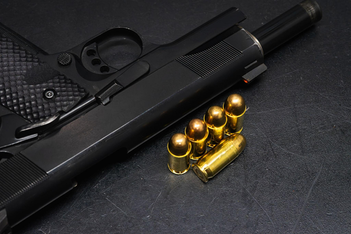How to Reduce Recoil in Your 1911
Jul 2nd 2025
The M1911 is a heavy, steel-framed pistol that absorbs recoil well. All the same, being chambered in .45 ACP, it’s not quite a 9mm. There are some shooters who might prefer a little less recoil if they could help it.
Of course, there’s always a tradeoff, and despite the relatively harder shove of the .45 ACP, it delivers great stopping power. There’s more than enough good reason this cartridge was trusted by the US Military for sidearm chamberings for almost 100 years.
Anyway, with all of this being the case, there are several things you can do to tame recoil in your 1911, and not all of them are 1911 parts and upgrades. Here are our notes.
Shoot Lighter Loads
The first and simplest thing you can do to tone down recoil is shoot lighter loads. The best way to do this is to look at a box of .45 ACP (assuming your 1911 is in the classic chambering) and look for a stat called muzzle velocity.
Muzzle velocity, being the product of muzzle velocity and bullet mass, is the primary determinant of felt recoil (though there are others, such as the mass of the gun). The lower the muzzle velocity rating, the less recoil there will be.
If you can’t find the muzzle velocity rating, hold everything else equal and shoot loads with lighter bullets or lower muzzle velocities.
These notes hold across all calibers, even if you have a 1911 that isn’t chambered in .45 ACP.
1911 Parts That Reduce Recoil
There are also a variety of 1911 parts that you can upgrade or replace in order to combat recoil in your M1911. Here are some of the best of them.
- 1911 compensators: Installing a compensator on your 1911 is the single most impactful step you can take to reduce recoil. A compensator is a muzzle device that alters how gasses are ported at the muzzle, and a good one can reduce felt recoil by as much as 50% without adversely affecting shot power. They’re also easy enough to install as long as you have a threaded muzzle. Even if you don’t, you may be able to replace your barrel with a 1911 barrel that is integrally suppressed.

- 1911 guide rods: This is a small step, but a step you can take nonetheless. Upgrading your 1911 with a guide rod that has more mass than your stock model will increase the static mass of the handgun, thereby counteracting felt recoil. The other thing is that a guide rod will strategically increase the mass near the muzzle, potentially shifting the center of gravity forward. This will help stabilize the muzzle and weigh it down, so the muzzle jumps less erratically when you shoot. In turn, this can not only counteract felt recoil but can potentially cut muzzle jump so you can make faster, more accurate follow up shots.
- Skeletonized 1911 slides: These are a little harder to find than the other 1911 parts mentioned here, but they can not only reduce felt recoil but also improve cycling speed. Heavy, steel 1911 slides are part of the gun’s reciprocating mass - that is, the mass that moves during cycling. The higher the reciprocating mass, the higher the felt recoil. By shaving some weight off the slide, you can directly cut felt recoil.
In addition to these 1911 parts, how you shoot the gun will also impact felt recoil, so we have some notes on that as well.
Adopting a Proper Grip and Stance
While learning how to properly hold the gun and adopting a good stance will not actually reduce the felt recoil of the gun, they will position you to absorb the recoil much more effectively, so they’re worth mentioning.
For one, get a good grip on the gun. Think high and tight: your shooting hand should be as high up on the grip as it can get, under the slide, without getting pinched by it. Lay your thumb along the frame right at the base of the slide and wrap all four fingers fully around the grip.
Lay your support hand fully over your shooting hand with your support thumb alongside your shooting thumb, at the base of the slide. Maximize surface area contact between your grip and the gun.
Extend your elbows till they are nearly straight, lock your wrists, and bend your knees slightly. The final step is to lean slightly forward at the waist, into the gun. This will shift your center of gravity just a little bit forward so that your body weight will help absorb the recoil from the shot.
Do this and see what sort of difference it makes at the range. You might be surprised.
Explore 1911 Parts and More Here
Here for 1911 parts like those mentioned, or are you looking for something else? Take a look through our catalog of 1911 accessories and parts (we also carry 1911 build kits if you are considering building your own at home rather than buying it) and get in touch with us directly at 610-250-3960 if you have any questions.

